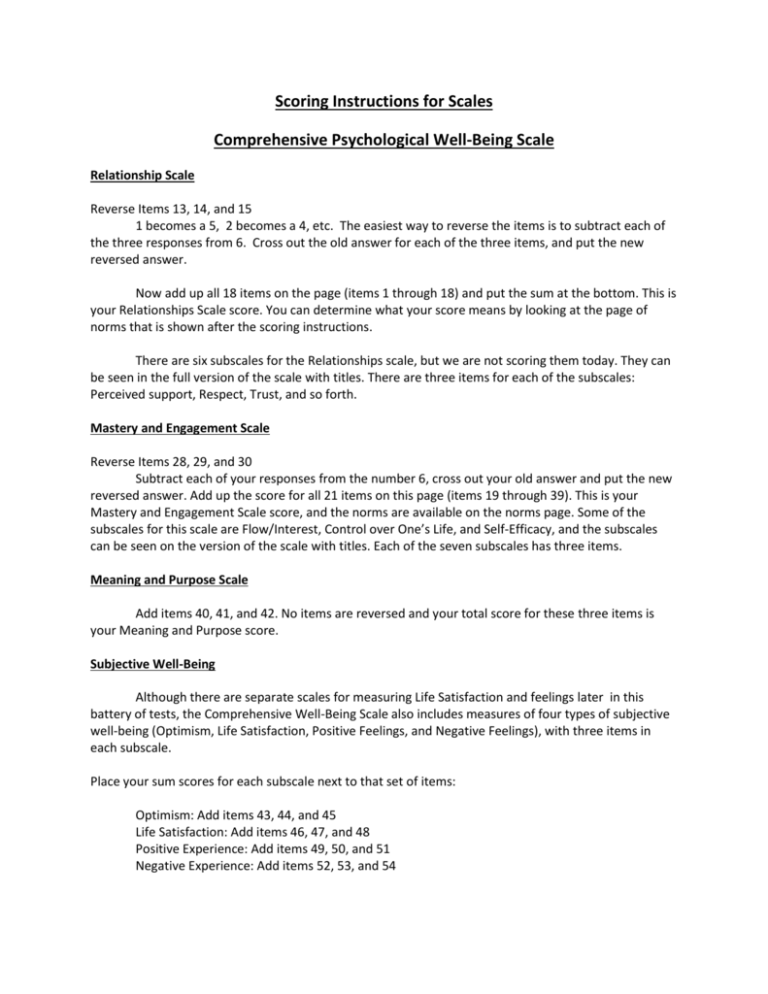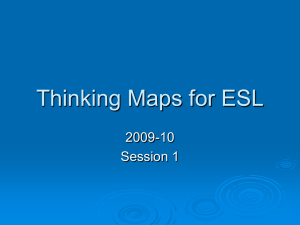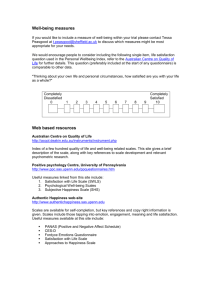Scale_Scoring_Instructions
advertisement

Scoring Instructions for Scales Comprehensive Psychological Well-Being Scale Relationship Scale Reverse Items 13, 14, and 15 1 becomes a 5, 2 becomes a 4, etc. The easiest way to reverse the items is to subtract each of the three responses from 6. Cross out the old answer for each of the three items, and put the new reversed answer. Now add up all 18 items on the page (items 1 through 18) and put the sum at the bottom. This is your Relationships Scale score. You can determine what your score means by looking at the page of norms that is shown after the scoring instructions. There are six subscales for the Relationships scale, but we are not scoring them today. They can be seen in the full version of the scale with titles. There are three items for each of the subscales: Perceived support, Respect, Trust, and so forth. Mastery and Engagement Scale Reverse Items 28, 29, and 30 Subtract each of your responses from the number 6, cross out your old answer and put the new reversed answer. Add up the score for all 21 items on this page (items 19 through 39). This is your Mastery and Engagement Scale score, and the norms are available on the norms page. Some of the subscales for this scale are Flow/Interest, Control over One’s Life, and Self-Efficacy, and the subscales can be seen on the version of the scale with titles. Each of the seven subscales has three items. Meaning and Purpose Scale Add items 40, 41, and 42. No items are reversed and your total score for these three items is your Meaning and Purpose score. Subjective Well-Being Although there are separate scales for measuring Life Satisfaction and feelings later in this battery of tests, the Comprehensive Well-Being Scale also includes measures of four types of subjective well-being (Optimism, Life Satisfaction, Positive Feelings, and Negative Feelings), with three items in each subscale. Place your sum scores for each subscale next to that set of items: Optimism: Add items 43, 44, and 45 Life Satisfaction: Add items 46, 47, and 48 Positive Experience: Add items 49, 50, and 51 Negative Experience: Add items 52, 53, and 54 Brief Psychological Well-Being Scale The BPWBS is a short version of the Comprehensive scale, and contains only 10 items. Depending on the situation, either the Comprehensive Scale or the Brief Scale would be given, not both. However, the Brief scale items are contained in the longer scale, and so we can compute your brief score. However, when the Brief Scale is given, the 10 items are given by themselves. So as not to repeat the items we did not give you these items a second time, but the scale can be seen as it should be given at the top of the list of scales with titles. Brief PWB Scale: Add items: 3, 16, 20, 31, 34, 37, 40, 43, 48, and 51 The sum of these 10 items represents your Brief score. You can write Brief Score somewhere on Page 1 and put your sum. Flourishing Scale The Flourishing Scale is similar to the Brief PWB Scale, and is a quick measure of overall wellbeing. The scale contains 8 items and can be used where specific subscale scores are not absolutely necessary. The Brief Scale and the Flourishing Scale will take most respondents only a minute to complete. Flourishing Scale: Add items 55 through 62, and place your sum next to these items. Satisfaction with Life Scale The SWLS is a widely used scale that has been cited over 7,500 times in the scientific literature. The scale assesses people’s global satisfaction with their life. SWLS: Add items 63 through 67 and place your sum next to these items. SPANE (Scale of Positive and Negative Experiences) Positive Experience Subjective well-being includes not only thoughtful reflective appraisals as in life satisfaction, but also positive and negative experiences, which is how people feel about what is happening to them. PE Score: Add items 68, 70, 72, 74, 77, and 79 and write this sum next to Positive at the top Negative Experience Negative Experience represents subjective ill-being, and so a low score is higher well-being on this scale. NE Score: Add items 69, 71, 73, 75, 76, and 78 and write this sum next to Negative at the top Cantril’s Ladder Hadley Cantril invented his Self-Anchoring Self-Striving Scale (1965) to assess something akin to life satisfaction, the person’s appraisal of their life based on the Best versus Worst life they can imagine for themselves. Since it is very quick it is often used in very large surveys, such as the Gallup World Poll. Scoring is very straightforward since it is whatever number the person chooses. Scale NORMS (What Your Scores Mean) Scale norms help us interpret our scores. They tell us where we stand on the scales compared to most other people. The average person scores in the positive direction on wellbeing scales and so a positive score might still be only average, and a score at the midpoint of a scale might be below average well-being. Scale Norm Description Score Range Your Score Comprehensive PWBS Relationships Very Low Low Average High Very High (Range is 18 to 90) 18 – 54 55 – 63 64 – 71 72 – 81 82 - 90 Very Low Low Average High Very High (Range is 21 to 105) 21 – 63 64 – 73 74 – 83 _______ 84 – 95 96 - 105 Very Low Low Average High Very High (Range is 3 to 15) 3–8 9 - 10 11 12 - 13 14 - 15 Very Low Low Average High Very High (Range is 3 to 15) 3–8 9 - 10 11 12 - 13 14 - 15 Mastery/Engagement Meaning & Purpose Optimism _______ _______ _______ Life Satisfaction (Range is 3 to 15) Very Low Low Average High Very High 3–8 9 - 10 11 12 - 13 14 - 15 Positive Experience (Range is 3 to 15) Very Low Low Average High Very High Negative Experience (Low score is high SWB) _______ 3–8 9 - 10 11 12 - 13 14 - 15 _______ (Range is 3 to 15) Very Low Low Average High Very High 3–8 9 - 10 11 12 - 13 14 - 15 Very Low Low Average High Very High (Range 10 – 50) 10 – 30 31 – 37 38 – 40 41 – 44 45 – 50 Very Low Low Average High Very High (Range 8 - 56) 8 – 38 39 – 43 44 – 47 48 – 51 52 – 56 Brief PWBS Flourishing Scale Satisfaction with Life Scale (SWLS) _______ (Range 5 – 35) Very Low Low Average High Very High 5 - 17 18 - 22 23 – 27 28 - 31 32 - 35 _______ SPANE Positive Experience Negative Experience (Low score is high SWB) (Range 6 – 30) Very Low Low Average High Very High 6 - 18 19 - 21 22 – 23 24 - 25 26 - 30 _______ Very Low Low Average High Very High 6 - 12 13 - 14 15 – 16 17 - 18 19 - 30 _______ Cantril’s Scale (Range 0 – 10) Very Low Low Average High Very High 0–3 4 5-6 7-8 9 – 10 _______ Note: Norms for Comprehensive and Brief Scales are based primarily on USA respondents. For Flourishing, SWLS, and SPANE, the norms are based on college students. For Cantril’s Ladder norms are based on representative sample of the world. The norms are based in part on the average responses to the scales. ALTERNATIVE NORM (ABSOLUTE, NOT COMPARED TO OTHERS): On 1 to 5 scales: HOW MUCH AM I ABOVE 3.0 PER ITEM, ABOVE NEUTRALITY? 4.0 = VERY GOOD; 5.0 = OUTSTANDING On 1 to 7 scales: HOW MUCH AM I ABOVE 4.0 PER ITEM, ABOVE NEUTRALITY? 5 = GOOD; 6 = HIGH; 7 = EXTREMELY HIGH








